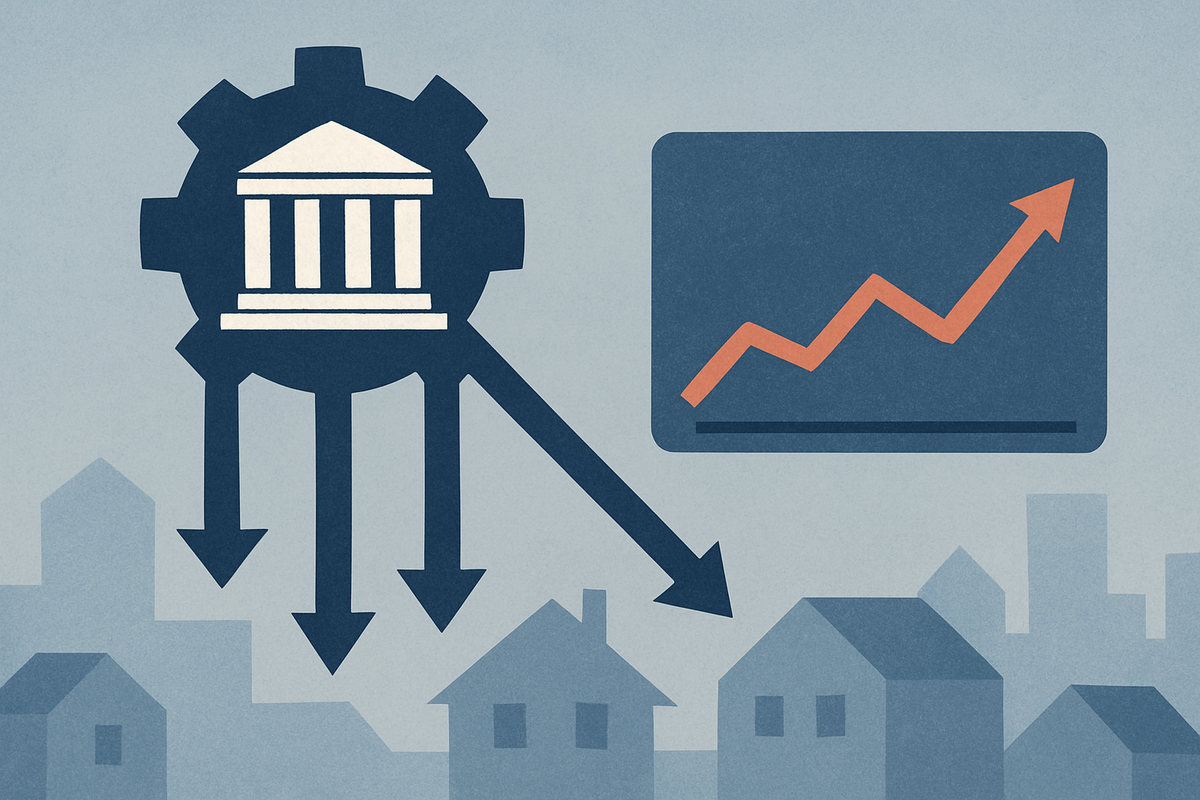
Despite recent actions by the Federal Reserve to cut benchmark interest rates, a perplexing and potentially long-lasting disconnect has emerged: mortgage rates are not following suit. This "sticky" mortgage rate phenomenon, driven by a complex interplay of market forces beyond the Fed's direct control, is reshaping the landscape for homebuyers, real estate investors, and financial institutions, signaling a new era of higher borrowing costs for housing. As of October 2025, the average 30-year fixed mortgage rate remains stubbornly in the mid-6% range, defying expectations that Fed easing would swiftly translate into more affordable home loans.
This divergence presents a critical challenge to the conventional wisdom that lower Fed rates automatically equate to a cheaper housing market. It underscores that while the Federal Reserve influences short-term borrowing, long-term mortgage rates are governed by a broader array of economic indicators, including inflation expectations, bond market dynamics, and investor sentiment. The implications are profound, suggesting a prolonged period of affordability constraints for prospective homeowners and a need for strategic re-evaluation across the real estate and financial sectors.
The Underlying Dynamics: Why Mortgage Rates Defy the Fed
The Federal Reserve's primary tool, the federal funds rate, directly impacts short-term borrowing costs for banks. However, fixed-rate mortgage rates, which constitute the vast majority of home loans, are more closely tied to the bond market, specifically the yield on the 10-year U.S. Treasury note. This benchmark yield reflects the market's long-term outlook on inflation and economic growth, often moving independently of the Fed's short-term policy.
One of the most significant factors keeping mortgage rates elevated is inflation expectations. Lenders and investors demand higher yields on long-term assets, such as mortgage-backed securities (MBS) and Treasury bonds, to compensate for the anticipated erosion of future purchasing power. If investors foresee persistent inflation, they will require a greater return on their investments, pushing mortgage rates upward. Recent data from September 2025, showing increased household inflation expectations, highlights this ongoing pressure.
Bond market dynamics also play a crucial role. Mortgage rates typically maintain a spread of 2-3% above the 10-year Treasury yield. When bond prices fall, their yields rise, and mortgage rates tend to follow. The Fed's ongoing quantitative tightening (QT), where it reduces its holdings of Treasury securities and MBS, effectively removes liquidity from the market, exerting upward pressure on long-term yields. Furthermore, if markets have already "priced in" anticipated Fed rate cuts, the actual cuts may not cause further drops in yields.
Finally, investor sentiment significantly influences mortgage rates. During periods of economic uncertainty or high risk aversion, investors often flock to safer assets like U.S. Treasury bonds, driving down yields. Conversely, if investors are optimistic about economic growth or perceive other sectors (like AI) as more lucrative, they might shift capital away from bonds, causing yields to rise. Minneapolis Fed President Neel Kashkari has even suggested that heavy investment in AI data centers could divert capital from housing, contributing to elevated mortgage rates. This complex interplay ensures that mortgage rates can remain "sticky" even as the Fed attempts to ease monetary policy.
Companies and Sectors Navigating the "Higher for Longer" Housing Market
A sustained period where Federal Reserve rate cuts fail to significantly lower mortgage rates creates clear winners and losers across various sectors, particularly those with deep ties to the housing market.
Companies that would likely lose include those heavily reliant on robust housing market activity and affordable financing. Mortgage lenders and originators such as Rocket Companies (NYSE: RKT) and UWM Holdings Corporation (NYSE: UWMC) would see reduced new mortgage applications and refinancing volumes. The "lock-in effect," where homeowners with low existing rates are reluctant to sell, further limits their business. Real estate brokerages and agencies, including Anywhere Real Estate Inc. (NYSE: HOUS) and RE/MAX Holdings (NYSE: RMAX), would suffer from fewer home sales transactions and, consequently, lower commission revenues. Homebuilders like D.R. Horton (NYSE: DHI), Lennar Corporation (NYSE: LEN), and PulteGroup (NYSE: PHM) would face diminished buyer demand due to affordability issues and increased costs for financing land acquisition and construction loans, squeezing their profit margins. Similarly, building materials suppliers such as The Home Depot (NYSE: HD) and Lowe's Companies (NYSE: LOW), and home furnishings retailers like Williams-Sonoma (NYSE: WSM), would experience reduced demand as fewer homes are bought, sold, or renovated. The commercial real estate (CRE) sector, particularly office and retail, would also face headwinds from higher borrowing costs for acquisitions and developments.
Conversely, certain sectors and companies could either win or exhibit relative resilience. Apartment REITs and rental housing companies like Equity Residential (NYSE: EQR), AvalonBay Communities (NYSE: AVB), and Essex Property Trust (NYSE: ESS) stand to benefit significantly. As homeownership becomes less accessible, more individuals and families are compelled to rent, leading to increased demand, higher occupancy rates, and potentially stronger rent growth for these entities. Diversified banks with strong deposit bases, such as JPMorgan Chase & Co. (NYSE: JPM) and Bank of America Corp. (NYSE: BAC), might maintain healthy net interest margins (NIMs) if long-term rates remain elevated while their cost of funds remains relatively low, despite potential dips in mortgage lending volumes. Insurance companies like The Allstate Corporation (NYSE: ALL), The Travelers Companies, Inc. (NYSE: TRV), and Chubb Limited (NYSE: CB) could also see improved investment income from their fixed-income portfolios if interest rates stay elevated. Finally, companies with stable, recurring revenue streams and low interest rate sensitivity, such as utility companies (e.g., Eversource Energy - NYSE: ES) and waste management services (e.g., Waste Management - NYSE: WM), are likely to remain resilient against housing market fluctuations.
Wider Significance: A Structural Shift in the Housing Economy
The persistent decoupling of Federal Reserve rate cuts from mortgage rate movements signifies a structural shift with far-reaching implications for the broader economy, industry trends, and regulatory landscape. As of October 2025, the U.S. housing market is grappling with a pronounced "lock-in effect," where homeowners with historically low mortgage rates (some below 3.75%) are hesitant to sell. This severely restricts housing supply, contributing to sustained home price appreciation in many areas despite high borrowing costs, rendering only about 28% of U.S. homes affordable for the typical household.
This scenario fits into a broader trend of decoupling mortgage rates from the Fed funds rate, emphasizing that long-term rates are more responsive to bond market yields and the pricing of Mortgage-Backed Securities (MBS). The Fed's ongoing quantitative tightening (QT) further exacerbates this by reducing liquidity, thereby putting upward pressure on long-term rates. Investor sentiment and inflation expectations remain paramount; if investors anticipate higher inflation, they demand greater yields, pushing mortgage rates higher. Minneapolis Fed President Neel Kashkari's observation that AI investment is diverting capital from housing also highlights a new, powerful economic force influencing capital allocation and potentially keeping housing finance costs elevated.
The ripple effects are widespread. Mortgage lenders face reduced origination volumes, while real estate agents and homebuilders experience fewer transactions. Ancillary industries, from home improvement to furniture retail, also feel the pinch of reduced housing activity. In response, regulators and policymakers might consider direct intervention in the MBS market (similar to past quantitative easing), introduce targeted housing programs to aid homebuyers, or implement policies to address supply-side issues like zoning reform. They will also intensify monitoring of financial stability within the mortgage sector and refine the Fed's communication strategy to manage public expectations about rate impacts.
Historically, reductions in the federal funds rate have not always led to proportional declines in mortgage rates. After the 2008 financial crisis, despite the Fed's aggressive easing, mortgage rates did not fall commensurately due to risk aversion and other market factors, until the Fed's large-scale asset purchases (QE) provided direct intervention. More recently, in late 2024, the Fed's rate cuts were surprisingly met with a rise in mortgage rates into early 2025, underscoring that broader market anticipation and economic fundamentals often outweigh immediate Fed actions. This historical context reinforces that the current "sticky rate" environment is not unprecedented but rather a recurring challenge in complex financial markets.
What Comes Next: Navigating a New Housing Reality
The sustained disconnect between Federal Reserve rate cuts and mortgage rates heralds a new, more challenging, but ultimately adaptable environment for the housing market, the broader economy, and financial sectors. This "new normal" of higher borrowing costs is unlikely to dissipate quickly, necessitating strategic pivots from all stakeholders.
In the short-term (next 12-24 months), affordability will remain the dominant challenge for homebuyers, particularly first-timers. The "lock-in effect" will continue to constrain the supply of existing homes, leading to sluggish sales activity and only modest home price growth, if any. Demand for rental properties is expected to remain robust, potentially fueling rent inflation. Economically, a prolonged slowdown in housing could weigh on overall GDP growth and consumer spending. Financial institutions heavily reliant on mortgage origination will face profitability pressures, though diversified banks may fare better.
Looking long-term (3-5+ years), this environment could lead to a generational divide in homeownership, with younger demographics facing persistent barriers. There might be a shift towards smaller, more affordable housing options and increased investor presence in the rental market. Innovation in housing finance, such as shared equity programs or new government-backed loans, could gain traction. Economically, if sticky rates are a symptom of structural inflation, the Fed might be forced into more aggressive or prolonged tightening cycles. Capital reallocation, potentially towards AI data centers, could lead to underinvestment in residential construction, exacerbating supply issues.
Strategic pivots will be crucial. Homebuyers must adjust budgets, explore alternative mortgage products like adjustable-rate mortgages (ARMs) with improved structures, consider buying down rates with points, or focus on government-backed loans. Real estate investors should prioritize cash flow-positive properties, increase cash contributions, seek value-add opportunities, and explore alternative financing methods like owner financing. They should also focus on long-term hold strategies and diversify investments. Financial institutions will need to diversify product offerings beyond traditional fixed-rate mortgages, enhance risk management, focus on portfolio retention, and explore new revenue streams less dependent on long-term mortgage rates.
This environment presents both opportunities and challenges. Opportunities include increased negotiating power for cash buyers, growth in the rental market, and potential for niche market expansion (e.g., build-to-rent communities). Challenges include a deepening housing affordability crisis, persistent supply shortages, risk of economic stagnation, and financial stress for highly leveraged investors. Potential scenarios range from a "New Normal" of rates stabilizing in the 6-7% range, leading to a structural shift in homeownership, to an "Inflationary Spiral" where the Fed might need to raise rates again, causing a more severe economic slowdown. A "Gradual Adjustment" scenario, where rates slowly decline over an extended period, represents a more optimistic but still slow path to recovery.
Wrap-up: A New Era for Housing Finance
The persistent "stickiness" of mortgage rates, even in the face of Federal Reserve rate cuts, marks a significant departure from conventional market dynamics. This disconnect, driven by stubborn inflation expectations, bond market volatility, and shifting capital allocation, underscores that the direct leverage of central bank short-term policy on long-term consumer borrowing costs for housing is less direct than commonly assumed. It has ushered in a new era for housing finance, characterized by recalibrated expectations and a more challenging path to homeownership.
As of October 2025, the market is assessing a future where mortgage rates are unlikely to return to the ultra-low levels of the past decade anytime soon. Forecasts suggest rates could hover in the mid-6% range through 2025, with more optimistic projections for late 2026 contingent on significant disinflation. This prolonged period of elevated rates, coupled with high home prices, has created a persistent affordability crisis, making homeownership a more challenging endeavor for many Americans and tempering the housing market's potential for rapid recovery. The lasting impact will likely be a fundamental shift in what constitutes a "normal" mortgage rate, highlighting the growing influence of broader economic fundamentals over direct central bank interventions.
For investors, vigilance is paramount. In the coming months, closely monitor inflation data, particularly the core Personal Consumption Expenditures (PCE) price index, as it remains a key determinant for long-term rates. Track 10-year Treasury yields as the most direct signal for mortgage rate trajectory. Pay attention to the mortgage-Treasury spread; a narrowing gap would indicate a more favorable environment for mortgage rate declines, suggesting lenders are reducing their risk premiums. Beyond rate decisions, Federal Reserve commentary on future policy intentions and economic outlook will continue to sway market sentiment. Lastly, keep an eye on economic growth and labor market reports; signs of a significant slowdown could prompt more aggressive Fed action, potentially exerting stronger downward pressure on rates.
The era of readily available, ultra-low mortgage rates directly tied to immediate Fed policy appears to be behind us. A nuanced understanding of the multiple, interconnected forces shaping mortgage rates is now essential for informed decision-making in the current and future housing market.
This content is intended for informational purposes only and is not financial advice







